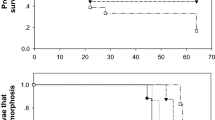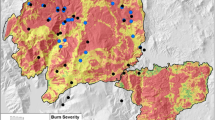Abstract
The frequency and duration of droughts are predicted to increase with global warming, increasing the risk of wildland fires. This motivates research into how drought interacts with management practices to control fires, especially in non-target ecosystems. Fire-retardant chemicals help prevent or control fires, but adversely affect the natural (pristine) ecological status in aquatic ecosystems. Using a multiple before-after control-impact design, and univariate and multivariate statistics, this study assesses population- and community-level responses of zooplankton to the single and compounded effects of drought and contamination in experimental field mesocosms. The contamination treatment simulated real scenarios of dosage-dependent fire-retardant pollution. Drought and contamination interacted in ways that caused complex synergistic or antagonistic responses in zooplankton. Response patterns differed between population-level and community-level assessments. Also, zooplankton population responses to drought and contamination impacts were context specific. This study provides an example of a management dilemma for areas affected by droughts. Not only will drought increase the risk of wildland fires but also complicate the prediction of ecological impact in aquatic environments when using retardant chemicals as a fire control and mitigation option. Management trade-offs are needed to minimize the uncertainties related to ecological damage from wildland fires and protect valuable but scarce water resources.



Similar content being viewed by others
References
Adams, S. M., & Greeley, M. S. (2000). Ecotoxicological indicators of water quality: using multi-response indicators to assess the health of aquatic ecosystems. Water, Air, and Soil Pollution, 123, 103–115.
Angeler, D. G. (2009). Species-specific and context-dependent disruption of population fluctuations resulting from hypereutrophication events. Environmental Pollution, 157, 3174–3182.
Angeler, D. G., & Moreno, J. M. (2006). Impact-recovery patterns of water quality in temporary wetlands after fire retardant pollution. Canadian Journal of Fisheries and Aquatic Sciences, 63, 1617–1626.
Angeler, D. G., & Moreno, J. M. (2007). Zooplankton community resilience after press-type anthropogenic stress in temporary ponds. Ecological Applications, 17, 1105–1115.
Angeler, D. G., Rodríguez, M., Martín, S., & Moreno, J. M. (2004). Assessment of application rate dependent impacts of a long-term fire retardant chemical (Fire-Trol 934®) on Typha domingensis germination. Environment International, 30, 375–381.
Angeler, D. G., Martín, S., & Moreno, J. M. (2005). Daphnia emergence: a sensitive indicator of fire retardant stress in temporary wetlands. Environment International, 31, 615–620.
Angeler, D. G., Sánchez, B., García, G., & Moreno, J. M. (2006). Community ecotoxicology: invertebrate emergence from Fire-Trol 934 contaminated vernal pool and salt marsh sediments under contrasting photoperiod and temperature regimes. Aquatic Toxicology, 78, 167–175.
Arnott, S. E., & Yan, N. D. (2002). The influence of drought and reacidification on zooplankton emergence from resting stages. Ecological Applications, 12, 138–153.
Blake, D., Lu, K., Horowitz, P., & Boyce, M. C. (2013). Fire suppression and burnt sediments: effects on the water chemistry of fire-affected wetlands. International Journal of Wildland Fire, 21, 557–561.
Boix, D., Sala, J., & Moreno-Amich, R. (2001). The faunal composition of Espolla pond (NE Iberian Peninsula): the neglected biodiversity of temporary waters. Wetlands, 21, 577–592.
Boix, D., Gascón, S., Sala, J., Martinoy, M., Gifre, J., & Quintana, X. D. (2005). A new index of water quality assessment in Mediterranean wetlands based on crustacean and insect assemblages: the case of Catalunya (NE Iberian peninsula). Aquatic Conservation: Marine and Freshwater Ecosystems, 15, 635–651.
Bond, N. R., Lake, P. S., & Arthington, A. H. (2008). The impacts of drought on freshwater ecosystems: an Australian perspective. Hydrobiologia, 600, 3–16.
Brockwell, P., & Davis, R. (2002). Introduction to time series and forecasting. Springer.
Clarke, K. R. (1993). Non-parametric multivariate analysis of changes in community structure. Australian Journal of Ecology, 18, 117–143.
Davies, G. M., Gray, A., Rein, G., & Legg, C. J. (2013). Peat consumption and carbon loss due to smouldering wildfire in a temperate peatland. Forest Ecology and Management, 308, 169–177.
De Meester, L., Declerck, S., Stoks, R., Louette, G., Van De Meutter, F., De Bie, T., Michels, E., & Brendonck, L. (2005). Ponds and pools as model systems in conservation biology, ecology and evolutionary biology. Aquatic Conservation: Marine and Freshwater Ecosystystems, 15, 715–725.
Dietrich, J. P., Myers, M. S., Strickland, S. A., Van Gaest, A., & Arkoosh, M. R. (2013). Toxicity of forest fire retardant chemicals to stream-type chinook salmon undergoing parr–smolt transformation. Environmental Toxicology and Chemistry, 32, 236–247.
Downes, B. J., Barmutta, L. A., Fairweather, P. G., Faith, D. P., Keough, M. J., Lake, P. S., Mapstone, B. D., & Quinn, G. P. (2002). Monitoring ecological impacts: concepts and practice in flowing waters. Cambridge: Cambridge University Press.
Fischer, J. M., Klug, J. L., Ives, A. R., et al. (2001). Ecological history affects zooplankton community responses to acidification. Ecology, 82, 2984–3000.
Folt, C. L., Chen, C. Y., Moore, M. V., & Burnaford, J. (1999). Synergisms and antagonisms among multiple stressors. Limnology and Oceanography, 44, 864–877.
Frost, T. M., Montz, P. K., Kratz, T. K., Badillo, T., et al. (1999). Multiple stresses from a single agent: diverse responses to the experimental acidification of Little Rock Lake, Wisconsin. Limnology and Oceanography, 44, 789–794.
Giménez, A., Pastor, E., Zarate, E., Planas, E., & Arnaldos, J. (2004). Long-term forest fire retardants: a review of quality, effectiveness, application and environmental considerations. International Journal of Wildland Fire, 13, 1–15.
Hillebrand, H., Bennett, D. M., & Cadotte, M. W. (2008). Consequences of dominance: a review of evenness effects on local and regional ecosystem processes. Ecology, 89, 1510–1520.
Holm, S. (1979). A simple sequentially rejective test procedure. Scandinavian Journal of Statistics, 6, 65–70.
Humphries, P., & Baldwin, D. S. (2003). Drought and aquatic ecosystems: an introduction. Freshwater Biology, 48, 1141–1146.
Kane, D. D., Gordon, S. I., Munawar, M., Charlton, M. N., & Culver, D. A. (2009). The planktonic index of biotic integrity (P-IBI): an approach for assessing lake ecosystem health. Ecological Indicators, 9, 1234–1247.
Keller, W. (2009). Limnology in northeastern Ontario: from acidification to multiple stressors. Canadian Journal of Fisheries and Aquatic Sciences, 66, 1189–1198.
Kneitel, J. M., & Chase, J. M. (2004). Trade-offs in community ecology: linking spatial scales and species co-existence. Ecology Letters, 7, 69–80.
Lahr, J. (1997). Ecotoxicology of organisms adapted to life in temporary freshwater ponds in arid and semi-arid regions. Archives of Environmental Contamination and Toxicology, 32, 50–57.
Lake, P. S. (2000). Disturbance, patchiness and diversity in streams. Journal of the North American Benthological Society, 19, 573–592.
Mitsch, W. J., & Gosselink, J. G. (2000). Wetlands (3rd ed.). New York: Wiley.
Moreno, L., Jiménez, M. E., Aguilera, H., Jiménez, P., & de la Losa, A. (2011). The 2009 smouldering peat fire in Las Tablas de Daimiel National Park (Spain). Fire Technology, 47, 519–538.
Orlowsky, B., & Seneviratne, S. I. (2012). Global changes in extreme events: regional and seasonal dimension. Climatic Change, 110, 669–696.
Pereira, M. G., Trigo, R. M., da Camara, C. C., Pereira, J. M. C., & Leite, S. M. (2005). Synoptic patterns associated with large summer forest fires in Portugal. Agricultural and Forest Meteorology, 129, 11–25.
San Miguel-Ayanz, J., Moreno, J. M., & Camia, A. (2013). Analysis of large fires in European Mediterranean landscapes: lessons learned and perspectives. Forest Ecology and Management, 294, 11–22.
Sánchez-Carrillo, S., & Alvarez-Cobelas, M. (2001). Nutrient dynamics and eutrophication patterns in a semiarid wetland: the effects of fluctuating hydrology. Water, Air, and Soil Pollution, 131, 97–118.
Sánchez-Carrillo, S., & Angeler, D.G. (Eds.) (2010). Ecology of threatened semiarid wetlands: Long-term research in Las Tablas de Daimiel. Wetlands: ecology, management and conservation. Series Ed. Max Findlayson. Springer.
Seneviratne, S. I., Nicholls, N., Easterling, D. C., Goodess, M., Kanae, S., Kossin, J., Luo, Y., Marengo, J., McInnes, K., Rahimi, M., Reichstein, M., Sorteberg, A., Vera, C., & Zhang, X. (2012). Changes in climate extremes and their impacts on the natural physical environment. In C. B. Field, V. Barros, T. F. Stocker, et al. (Eds.), Managing the risks of extreme events and disasters to advance climate change adaptation. A special report of working groups I and II of the intergovernmental panel on climate change (IPCC SREX Report) (pp. 109–230). Cambridge (UK), New York (USA), Cambridge University Press.
Sládeček, V. (1983). Rotifers as indicators of water quality. Hydrobiologia, 100, 169–201.
Swanson, S.M. (2004). Multiple stressors: Literature review and gap analysis. Water environment research foundation report (Project 00-ECO-2B). London, International Water Association Publishing.
Townsend, C. R., Uhlmann, S. S., & Matthaei, C. D. (2008). Individual and combined responses of stream ecosystems to multiple stressors. Journal of Applied Ecology, 45, 1810–1819.
Verdú, F., Salas, J., & Vega-García, C. (2012). A multivariate analysis of biophysical factors and forest fires in Spain, 1991–2005. International Journal of Wildland Fire, 21, 498–509.
Vinebrooke, R. D., Cottingham, K. L., Norberg, J., Scheffer, M., Dodosn, S. I., Maberly, S. C., & Sommer, U. (2004). Impacts of multiple stressors on biodiversity and ecosystem functioning: the role of species co-tolerance. Oikos, 104, 451–457.
Whitman, R. L., Nevers, M. B., Goodrich, M. L., Murphy, P. C., & Davis, B. M. (2004). Characterization of Lake Michigan coastal lakes using zooplankton assemblages. Ecological Indicators, 4, 277–286.
Williams, D. D. (2006). The biology of temporary waters. Oxford: Oxford University Press.
Zacharias, L., & Zamparas, M. (2010). Mediterranean temporary ponds. A disappearing ecosystem. Biodiversity and Conservation, 19, 3827–3834.
Zedler, J. B., & Kercher, S. (2005). Wetland resources: status, trends, ecosystem services, and restorability. Annual Review of Environment and Resources, 30, 39–74.
Acknowledgments
We thank A. Velasco, several undergraduate students, the Quintos de Mora staff and the project partners in France, Greece, and Portugal for many contributions to this study. The constructive criticism provided by two anonymous reviewers is gratefully acknowledged. Financial support was provided from the European Community research projects “ERAS” (contract number EVG1-2002-300019) and “WISER” (contract number 226273).
Author information
Authors and Affiliations
Corresponding author
Electronic supplementary material
Below is the link to the electronic supplementary material.
ESM 1
(XLS 39 kb)
Rights and permissions
About this article
Cite this article
Martín, S., Rodríguez, M., Moreno, J.M. et al. Complex Ecological Responses to Drought and Fire-Retardant Contamination Impacts in Ephemeral Waters. Water Air Soil Pollut 225, 2078 (2014). https://doi.org/10.1007/s11270-014-2078-7
Received:
Accepted:
Published:
DOI: https://doi.org/10.1007/s11270-014-2078-7




